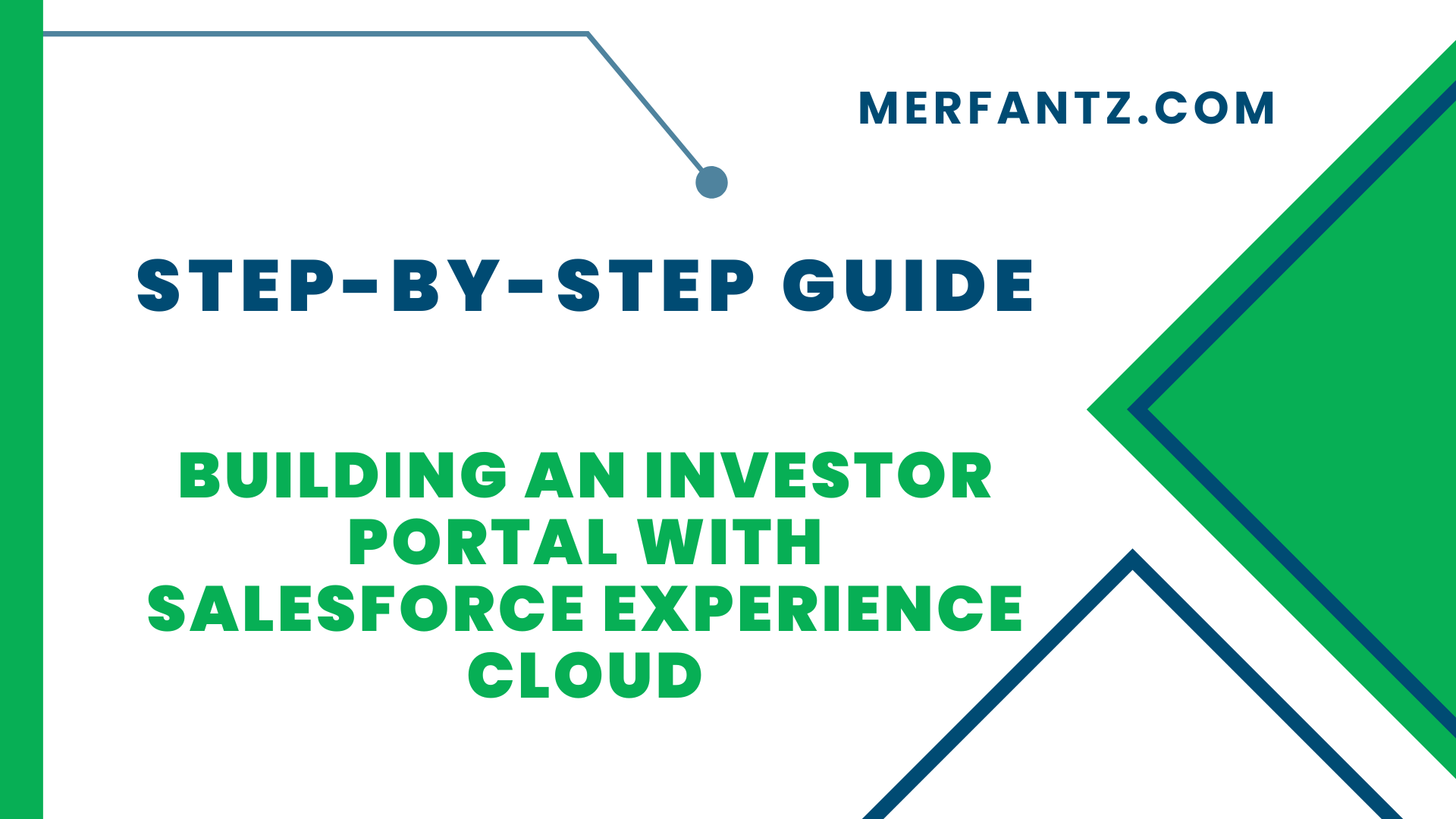Introduction to Investor Portals
Investor portals have emerged as a crucial tool in the modern business landscape, offering a secure and centralized platform for companies to communicate and collaborate with their investors. These portals serve as a dedicated space where businesses can provide valuable information, updates, and resources to their investors, fostering transparency and enhancing engagement. In today’s competitive market, leveraging investor portals has become essential for companies aiming to streamline their investor relations and maintain strong investor relationships. In this blog post, we will explore the significance of investor portals and how Salesforce Experience Cloud can be utilized to create a powerful and efficient portal.
As an investor, having access to an investor portal empowers you with timely information, reducing the need for manual communication and providing a seamless experience. Investor portals allow you to stay up-to-date with company news, financial reports, performance metrics, and other relevant data. They also offer a secure channel for document sharing, enabling you to access and review critical materials at your convenience. By utilizing Salesforce Experience Cloud, businesses can build robust and customizable investor portals that cater to the unique needs of their investors, ultimately fostering trust and enhancing overall investor satisfaction.
Understanding the Importance of Investor Portals in Today’s Business Landscape
Investor portals play a pivotal role in modern business landscapes, providing numerous benefits for both companies and investors. Firstly, they enhance transparency by offering real-time access to important financial information, reports, and updates. This transparency instills confidence in investors, enabling them to make well-informed decisions based on accurate and up-to-date data. Additionally, investor portals streamline communication channels, reducing the need for manual back-and-forth exchanges and ensuring that the right information reaches the right people in a timely manner.
Furthermore, investor portals contribute to improved investor relations by providing a centralized platform for engagement. Companies can leverage these portals to share company news, event invitations, and performance updates, fostering a sense of community among investors. Through features such as discussion forums or chat functionalities, investors can also interact with one another and engage in meaningful conversations, creating opportunities for networking and collaboration. Overall, investor portals have become a vital tool for businesses to nurture strong investor relationships and demonstrate their commitment to transparency and investor satisfaction.
Exploring the Features and Benefits of Salesforce Experience Cloud
Salesforce Experience Cloud is a powerful platform that offers a wide range of features and benefits for building investor portals. One of the key advantages is its ability to provide a personalized and intuitive user experience. With Salesforce Experience Cloud, companies can create customized dashboards and layouts tailored to the specific needs and preferences of their investors. This flexibility allows for seamless navigation and easy access to relevant information, enhancing the overall user experience.
Another notable feature of Salesforce Experience Cloud is its robust security measures. Data privacy and protection are critical when it comes to investor portals, as they often involve sensitive financial information. Salesforce Experience Cloud offers robust security features such as user authentication, data encryption, and access controls, ensuring that investor data remains secure and confidential. This not only instills trust in investors but also ensures compliance with data protection regulations.
Getting Started with Salesforce Experience Cloud
To begin building your investor portal with Salesforce Experience Cloud, you first need to set up your Salesforce environment. This involves creating a dedicated community within Salesforce Experience Cloud, which will serve as the foundation for your investor portal. You can customize the community’s branding, layout, and navigation to align with your company’s branding and user experience goals. Salesforce Experience Cloud provides a user-friendly interface and intuitive tools to simplify the setup process, making it accessible even for users without extensive technical knowledge.
Once your community is set up, the next step is to configure user access and permissions. This ensures that only authorized individuals can access the investor portal and its specific features and resources. Salesforce Experience Cloud allows you to define user roles and profiles, granting different levels of access based on the user’s role within your organization or their relationship with the investors. By setting up proper user access and permissions, you can ensure that confidential information remains secure while enabling investors to access the information relevant to them.
Setting Up Your Salesforce Environment for Investor Portal Development
Setting up your Salesforce environment for investor portal development requires a few essential steps. First, you need to define your objectives and determine the key functionalities and features you want to incorporate into your investor portal. This includes identifying the types of information you want to share with your investors, such as financial reports, performance metrics, and company updates. By clarifying your goals and requirements, you can effectively plan and structure your investor portal.
Next, you will need to configure your Salesforce Experience Cloud community. This involves creating a branded and visually appealing interface that reflects your company’s identity. You can customize the community’s layout, colors, fonts, and logos to provide a consistent brand experience to your investors. Salesforce Experience Cloud offers a variety of templates and customization options, making it easy to create a professional-looking investor portal without extensive design expertise.
Customizing the Investor Portal: Design and Branding Tips
Customizing the design and branding of your investor portal is crucial for creating a cohesive and engaging user experience. Start by incorporating your company’s branding elements, such as logos, colors, and fonts, into the portal’s design. This ensures that the portal aligns with your overall brand identity and creates a sense of familiarity for investors. Additionally, consider the layout and organization of the portal’s content to optimize usability and navigation. Ensure that important information is easily accessible and that the portal’s structure follows logical and intuitive user flows.
When customizing the investor portal, keep in mind the importance of responsive design. Salesforce Experience Cloud allows you to create mobile-responsive portals, ensuring that investors can access the portal and its content seamlessly across different devices, including smartphones and tablets. Responsive design not only enhances user experience but also demonstrates your commitment to providing a modern and accessible platform for your investors.
Building a User-friendly Investor Portal
When building an investor portal, prioritizing user-friendliness is essential to ensure a positive user experience. Begin by organizing the portal’s content in a logical and intuitive manner, grouping related information together and providing clear navigation menus. This allows investors to easily locate the resources and features they need, enhancing their overall satisfaction with the portal. Consider implementing search functionality and filters to further facilitate information retrieval, making it effortless for investors to find specific documents or data.
In addition to content organization, focus on creating a user-friendly interface with intuitive design elements. Use clear and concise language to convey information effectively, avoiding technical jargon or complex terminology whenever possible. Incorporate visual elements such as icons, charts, and infographics to enhance comprehension and engage investors visually. Remember to optimize loading times to minimize waiting periods, ensuring a smooth and efficient browsing experience for users.
Configuring User Access and Permissions
Configuring user access and permissions within your investor portal is crucial to maintain data security and provide personalized experiences. Salesforce Experience Cloud enables you to define roles, profiles, and permission sets, granting appropriate levels of access to different user groups. Consider creating different user profiles based on the roles and responsibilities of investors, such as shareholders, board members, or potential investors. This way, you can tailor the access and privileges to match their specific needs and ensure that confidential information remains accessible only to authorized individuals.
In addition to access control, you can implement features such as personalized dashboards and tailored content recommendations based on user preferences. By utilizing Salesforce Experience Cloud’s capabilities, you can provide a customized experience for each investor, delivering relevant updates, reports, and resources that align with their interests. This level of personalization not only enhances the user experience but also demonstrates your commitment to meeting individual investor needs, fostering stronger relationships and engagement.
Integrating Data and Analytics in Your Investor Portal
Integrating data and analytics capabilities into your investor portal can provide valuable insights and enhance decision-making for both companies and investors. Salesforce Experience Cloud allows you to integrate with other Salesforce products, as well as external data sources, enabling real-time data updates and comprehensive reporting. By leveraging these capabilities, you can provide investors with up-to-date financial information, key performance indicators, and market trends, empowering them to make informed investment decisions.
Furthermore, data analytics can help you track and analyze investor engagement and behavior within the portal. By implementing analytics tools, you can gain insights into which resources or sections of the portal are most frequently accessed, how investors navigate through the platform, and the effectiveness of different communication channels. This data-driven approach allows you to refine and optimize the portal’s content and features based on user preferences, improving the overall user experience and engagement.
Launching and Maintaining Your Investor Portal
Launching your investor portal marks an important milestone in your investor relations strategy. Before the launch, ensure that all the necessary content and resources are uploaded and organized within the portal. Conduct thorough testing to validate the functionality and user experience, making any necessary adjustments or refinements. Additionally, consider implementing a communication plan to notify investors about the upcoming launch and provide them with instructions on accessing the portal. Clear and concise communication will help generate excitement and encourage active participation from your investors.
Once the portal is launched, it is crucial to establish a plan for ongoing maintenance and updates. Regularly review the content to ensure it remains up to date and relevant. Monitor user feedback and engagement metrics to identify areas for improvement or additional features that can enhance the portal’s value. Regularly communicate with investors through newsletters or announcements to keep them informed about new resources, updates, or events. By maintaining an active and engaging investor portal, you can strengthen relationships, foster trust, and demonstrate your commitment to delivering exceptional investor experiences.
Best Practices for Successful Investor Portal Deployment and Ongoing Management
Deploying and managing an investor portal successfully requires adherence to best practices. Firstly, establish clear goals and objectives for your portal, ensuring that they align with your overall investor relations strategy. This will guide your decision-making process and help you prioritize the features and functionalities that are most valuable to your investors. Regularly review and assess the performance of the portal against these goals, making adjustments as needed to ensure continuous improvement.
Secondly, ensure that your investor portal provides easy access to support and assistance. Offer clear channels for investors to reach out with questions or issues, such as a dedicated help desk or a contact form. Promptly address inquiries and provide timely responses to demonstrate your commitment to investor satisfaction. Additionally, consider providing educational resources, tutorials, or FAQs within the portal to assist users in navigating the platform and accessing the information they need.
FAQ (Frequently Asked Questions)
What is an investor portal?
An investor portal is a secure online platform that allows companies to communicate and collaborate with their investors. It serves as a centralized hub where companies can share important information, updates, financial reports, and other resources with their investors. Investor portals enhance transparency, streamline communication, and foster strong investor relationships.
Why is Salesforce Experience Cloud recommended for building an investor portal?
Salesforce Experience Cloud is recommended for building an investor portal due to its powerful features and capabilities. It offers customization options, intuitive user interfaces, and responsive design to create a user-friendly experience. Salesforce Experience Cloud also provides robust security measures, data integration capabilities, and analytics tools for comprehensive investor engagement and insights.
How do I get started with building an investor portal using Salesforce Experience Cloud?
To get started, you need to set up your Salesforce environment and create a community within Salesforce Experience Cloud dedicated to your investor portal. Customize the community’s branding and layout to align with your company’s identity. Configure user access and permissions to ensure data security and personalize the user experience based on investor roles and preferences.
What features should an investor portal have?
An effective investor portal should have features such as real-time access to financial information, performance reports, secure document sharing, personalized dashboards, discussion forums, and integration with external data sources. The portal should be user-friendly, intuitive to navigate, and mobile-responsive to provide a seamless experience for investors across different devices.
How do I create an experience cloud site in Salesforce?
To create an Experience Cloud site in Salesforce, you can use the Experience Builder tool, which allows you to design and customize the site’s layout, branding, and content. Simply navigate to the Experience Builder in your Salesforce org, create a new site, define the site’s URL, configure the desired features and components, and publish the site.
What is Salesforce Experience Portal?
Salesforce Experience Portal, now known as Salesforce Experience Cloud, is a platform that allows organizations to build and deploy branded, personalized portals for their customers, partners, and employees. It provides a secure and customizable interface where users can access relevant information, collaborate, and engage with the organization.
How do I create an Experience User in Salesforce?
To create an Experience User in Salesforce, you need to first create a Community or Experience Cloud user profile. Then, assign the appropriate permissions and access settings to the user profile. Finally, create a new user record with the assigned user profile, specifying the necessary details such as username, email, and role within the Experience Cloud.
How does Salesforce Experience Cloud work?
Salesforce Experience Cloud allows organizations to create and manage personalized portals for their users, such as customers, partners, or employees. It utilizes the power of Salesforce’s CRM capabilities, data integration, and customization options to deliver a seamless and tailored user experience. Experience Cloud provides a unified platform where users can access relevant information, collaborate, and engage with the organization, ultimately driving customer satisfaction and organizational efficiency.
Conclusion:
In conclusion, building an investor portal with Salesforce Experience Cloud offers numerous benefits for companies and investors alike. By leveraging the power of Salesforce Experience Cloud, you can create a user-friendly, secure, and personalized portal that enhances transparency, engagement, and collaboration. Follow the step-by-step guide provided by Merfantz Technologies to set up and customize your investor portal, configure user access and permissions, integrate data and analytics, and launch and maintain your portal successfully. By implementing best practices and regularly updating and improving your investor portal, you can foster strong investor relationships, drive informed decision-making, and achieve success in your investor relations efforts.
Author Bio
Co-Founder & CMO at Merfantz Technologies Pvt Ltd | Marketing Manager for FieldAx Field Service Software | Salesforce All-Star Ranger and Community Contributor | Salesforce Content Creation for Knowledge Sharing






